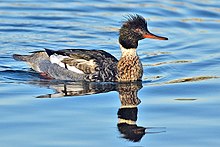
Back بلقشة Arabic بلقشه (جنس من الطيور) ARZ Nudol (Mergus) AVK Pazdimdik Azerbaijani Крахалі Byelorussian Нирци Bulgarian মার্গাস Bengali/Bangla Heskenneg Breton Mergus Catalan Mergus CEB
| Typical mergansers | |
|---|---|

| |
| Red-breasted merganser (Mergus serrator) | |
| Scientific classification | |
| Domain: | Eukaryota |
| Kingdom: | Animalia |
| Phylum: | Chordata |
| Class: | Aves |
| Order: | Anseriformes |
| Family: | Anatidae |
| Subfamily: | Anatinae |
| Genus: | Mergus Linnaeus, 1758 |
| Type species | |
| Mergus castor[1] Linnaeus, 1766
| |
| Species | |
|
†Mergus australis Auckland Island merganser | |
Mergus is the genus of the typical mergansers (/mɜːrˈɡænsərz/ mur-GAN-sərz)[2] fish-eating ducks in the subfamily Anatinae. The genus name is a Latin word used by Pliny the Elder and other Roman authors to refer to an unspecified waterbird.[3][4]
The common merganser (Mergus merganser) and red-breasted merganser (M. serrator) have broad ranges in the northern hemisphere. The Brazilian merganser (M. octosetaceus) is a South American duck, and one of the six most threatened waterfowl in the world, with possibly fewer than 250 birds in the wild. The scaly-sided merganser or "Chinese merganser" (M. squamatus) is an endangered species. It lives in temperate East Asia, breeding in the north and wintering in the south.
The hooded merganser (Lophodytes cucullatus, formerly known as Mergus cucullatus) is not of this genus but is closely related. The other "aberrant" merganser, the smew (Mergellus albellus), is phylogenetically closer to goldeneyes (Bucephala).
Although they are seaducks, most of the mergansers prefer riverine habitats, with only the red-breasted merganser being common at sea. These large fish-eaters typically have black-and-white, brown and/or green hues in their plumage, and most have somewhat shaggy crests. All have serrated edges to their long and thin bills that help them grip their prey. Along with the smew and hooded merganser, they are therefore often known as "sawbills". The goldeneyes, on the other hand, feed mainly on mollusks, and therefore have a more typical duck-bill.[5]
Mergus ducks are also classified as "diving ducks" because they submerge completely in looking for food. In other traits, however, the genera Mergus, Lophodytes, Mergellus, and Bucephala are very similar: uniquely among all Anseriformes, they do not have notches at the hind margin of their sternum, but holes surrounded by bone.[6]
- ^ "Anatidae". aviansystematics.org. The Trust for Avian Systematics. Retrieved 2023-08-05.
- ^ "merganser". The Chambers Dictionary (9th ed.). Chambers. 2003. ISBN 0-550-10105-5.
- ^ Jobling, James A (2010). The Helm Dictionary of Scientific Bird Names. London: Christopher Helm. p. 251. ISBN 978-1-4081-2501-4.
- ^ Cite error: The named reference
Arnottwas invoked but never defined (see the help page). - ^ "Common Goldeneye". Seattle Audubon Society. Retrieved 18 April 2014.
- ^ Cite error: The named reference
Livezeywas invoked but never defined (see the help page).
© MMXXIII Rich X Search. We shall prevail. All rights reserved. Rich X Search